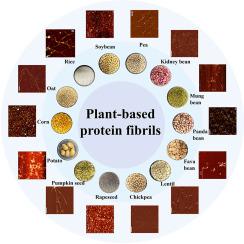Recent progress of plant protein-based amyloid-like nanofibrils
IF 11
1区 农林科学
Q1 CHEMISTRY, APPLIED
引用次数: 0
Abstract
Amyloid-like protein nanofibrils with several nanometers in thickness and nanometer or micrometer in length have received great attention due to the high aspect ratio, tunable flexibility, and ordered arrangement. Various food proteins have been reported to self-assemble into fibrillar structures by prolonged heating under low pH conditions. Although animal proteins are the main resources for synthesizing amyloid-like fibrils currently, extensive progress has been made in the fabrication of fibrils using plant-sourced proteins owing to sustainability compared to animal resources. Herein, we comprehensively reviewed the plant protein resources that have been reported to synthesize fibrils. We also described the fibrillization process and factors impacting fibril formation. Furthermore, we described their formation mechanisms and highlighted the factors that influence the hydrolysis and self-assembly behavior. We offered new insights into the challenges of developing plant proteins with complex structural composition into fibrils. Finally, we introduced the potential applications of plant protein fibrils in food industries.

基于植物蛋白的淀粉样纳米纤维的最新研究进展
厚度为几纳米、长度为纳米或微米的淀粉样蛋白纳米纤维因其高宽比、可调柔性和有序排列而备受关注。据报道,在低 pH 值条件下,通过长时间加热,各种食品蛋白质可自组装成纤维状结构。虽然动物蛋白是目前合成淀粉样纤维的主要资源,但与动物资源相比,植物来源的蛋白质具有可持续性,因此在利用植物来源的蛋白质制造纤维方面取得了广泛的进展。在此,我们全面回顾了已报道的可合成纤丝的植物蛋白资源。我们还描述了纤维化过程和影响纤维形成的因素。此外,我们还描述了它们的形成机制,并强调了影响水解和自组装行为的因素。我们对将具有复杂结构组成的植物蛋白开发成纤维所面临的挑战提出了新的见解。最后,我们介绍了植物蛋白纤维在食品工业中的潜在应用。
本文章由计算机程序翻译,如有差异,请以英文原文为准。
求助全文
约1分钟内获得全文
求助全文
来源期刊

Food Hydrocolloids
工程技术-食品科技
CiteScore
19.90
自引率
14.00%
发文量
871
审稿时长
37 days
期刊介绍:
Food Hydrocolloids publishes original and innovative research focused on the characterization, functional properties, and applications of hydrocolloid materials used in food products. These hydrocolloids, defined as polysaccharides and proteins of commercial importance, are added to control aspects such as texture, stability, rheology, and sensory properties. The research's primary emphasis should be on the hydrocolloids themselves, with thorough descriptions of their source, nature, and physicochemical characteristics. Manuscripts are expected to clearly outline specific aims and objectives, include a fundamental discussion of research findings at the molecular level, and address the significance of the results. Studies on hydrocolloids in complex formulations should concentrate on their overall properties and mechanisms of action, while simple formulation development studies may not be considered for publication.
The main areas of interest are:
-Chemical and physicochemical characterisation
Thermal properties including glass transitions and conformational changes-
Rheological properties including viscosity, viscoelastic properties and gelation behaviour-
The influence on organoleptic properties-
Interfacial properties including stabilisation of dispersions, emulsions and foams-
Film forming properties with application to edible films and active packaging-
Encapsulation and controlled release of active compounds-
The influence on health including their role as dietary fibre-
Manipulation of hydrocolloid structure and functionality through chemical, biochemical and physical processes-
New hydrocolloids and hydrocolloid sources of commercial potential.
The Journal also publishes Review articles that provide an overview of the latest developments in topics of specific interest to researchers in this field of activity.
 求助内容:
求助内容: 应助结果提醒方式:
应助结果提醒方式:


